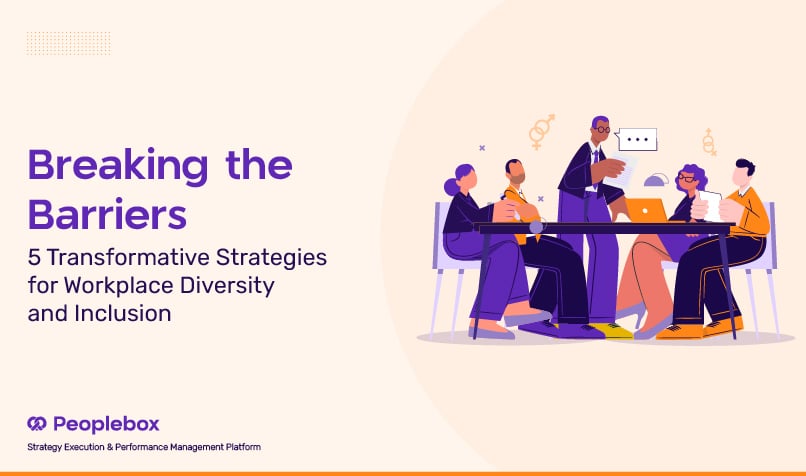Ditch the checkbox mentality. Master DEI to fuel organizational success!
In an increasingly interconnected and globalized world, the significance of diversity and inclusion in the workplace cannot be overstated. With 50 percent of U.S. employees now expecting their companies to invest more in promoting workplace diversity and inclusion, it’s evident that the responsibility for fostering D&I falls on every individual, but more so on the shoulders of HR professionals.
As the lines between nations and cultures blur, and as the concept of a “typical” employee continues to diversify, HR departments find themselves at the forefront of adapting to these changing dynamics.
In this blog post, we will explore how HR professionals can take the lead in promoting D&I within their organizations. Read along!

What Is Diversity And Inclusion In The Workplace?
Diversity and Inclusion in the workplace represent crucial elements that go beyond just numerical representation. Diversity in the workplace encompasses the spectrum of human differences, including but not limited to race, ethnicity, gender, age, sexual orientation, disability, religion, socio-economic status, and cultural background. It’s the recognition and appreciation of these differences among individuals.
Inclusion, on the other hand, is the deliberate cultivation of an environment where diverse individuals feel welcomed, respected, supported, and valued. It’s about creating an atmosphere where all voices are heard, and everyone has equal opportunities to contribute and succeed.
The essence of diversity is the ‘mix’, while inclusion is ‘making the mix work’. By fostering an inclusive workplace, organizations encourage collaboration, empathy, and understanding among individuals from different backgrounds and different groups, which ultimately leads to a more cohesive and high-performing team.
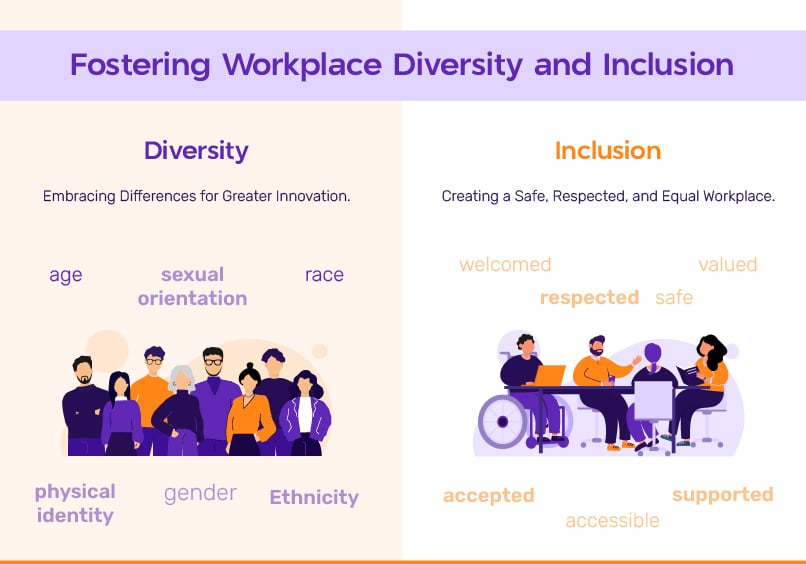
At Peoplebox, we reshape DEI success with our pioneering engagement framework. Rooted in 11 psychological drivers, our survey goes beyond conventions, using eNPS and a dynamic 5-point scale to measure with precision.
This approach offers nuanced insights, actionable feedback, and a clear understanding of successful behaviors, empowering companies to thrive in fostering Diversity, Equity, and Inclusion.
Benefits Of Diversity And Inclusion In The Workplace
The benefits of diversity and inclusion in the workplace are numerous and impactful, contributing to a more dynamic and successful organizational environment. Here are some key advantages:
Enhanced Creativity and Innovation
Diverse teams bring together a wide range of perspectives, experiences, and ideas. This diversity of thought fosters creativity and innovation, leading to unique problem-solving approaches and breakthrough solutions that a homogenous group might not have considered.
Improved Decision-Making
Different viewpoints and experiences contribute to more comprehensive and well-thought-out decisions. When diverse teams come together, they tend to consider a broader spectrum of possibilities and alternatives, resulting in better decision-making processes.
Attracting Top Talent
Companies that prioritize diversity and inclusion are often more appealing to a broad range of job seekers. Potential employees actively seek a diverse workplace where they feel valued and respected, leading to a larger and more diverse pool of talented candidates.
Better Customer Understanding and Service
A diverse workforce is better equipped to understand and serve diverse groups of people. Employees from various backgrounds bring new perspectives and skill sets that help in understanding different market segments and catering to a broader range of customer needs.
Increased Employee Engagement and Retention
In inclusive companies, employees feel valued, respected, and a sense of belonging. This leads to higher levels of engagement, job satisfaction, and a positive impact. Employees are more likely to stay with a company where they feel included and appreciated for their unique contributions.
Enhanced Company Reputation and Brand
A commitment to diversity and inclusion contributes positively to a company’s brand and reputation. Organizations that value diversity are viewed as socially responsible and forward-thinking, which can attract a more diverse customer base and strengthen relationships with stakeholders.
Compliance and Avoidance of Discrimination Issues
Prioritizing diversity and inclusion aids in compliance with anti-discrimination laws and regulations. A workplace culture that values diversity reduces the risk of legal issues related to discrimination.
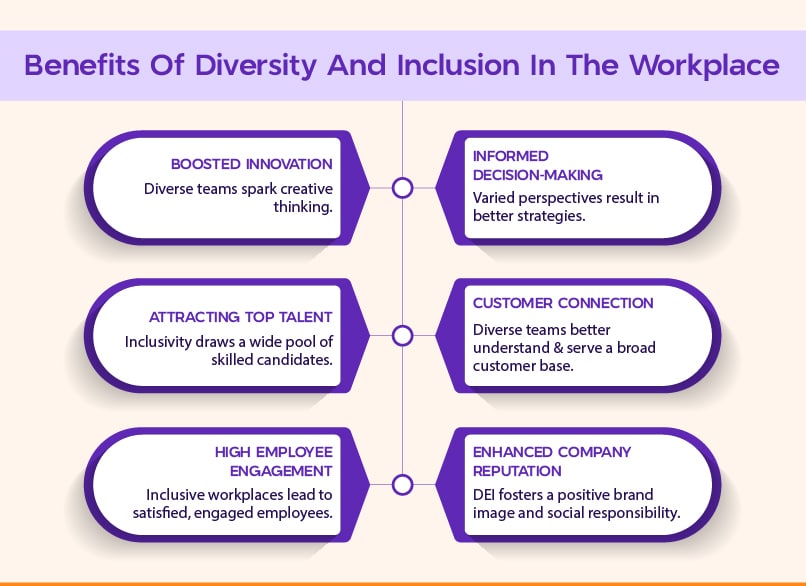
5 Strategies To Improve Diversity And Inclusion In Workplaces
Now that we’ve established the benefits of diversity in the workplace, and know that diversity and inclusion is more than just a checkbox item, let us look at 5 ways in which you can help foster diversity and inclusion at your workplace.
1. Conduct Employee Surveys to Evaluate Diversity and Inclusion in the Workplace
Evaluating your organization’s Diversity, Equity, and Inclusion (DEI) status is the first step in your journey toward creating a more inclusive workplace. Employee surveys are a valuable tool for gathering feedback, understanding the current state of DEI, and identifying areas for improvement. When crafted thoughtfully and distributed effectively, they can yield a wealth of information regarding your organization’s DEI initiatives.

Here are some key reasons why these surveys matter:
- Data-Driven Insights: Surveys are data goldmines, offering a quantitative understanding of your organization’s DEI landscape. This data isn’t just numbers; it’s the foundation for making well-informed decisions about DEI strategies.
- Anonymous Feedback: Employee surveys provide a safe, anonymous platform for your team members to express their thoughts candidly. This anonymity fosters honesty and accuracy in their responses, revealing genuine sentiments without fear of repercussions.
- Boosting Employee Engagement: By involving employees in shaping DEI initiatives through surveys, you not only gain valuable insights but also enhance their engagement and sense of ownership in the DEI process.
- Continual Improvement: Regular surveys are the compass guiding you towards progress. They help you track your DEI journey, make necessary adjustments, and ensure you’re consistently moving towards a more inclusive workplace.
At Peoplebox, we offer a robust solution for employee surveys that streamlines the process, making it efficient and effective. With Peoplebox, you have the power of customization at your fingertips, allowing you to create surveys from scratch or choose from a library of templates to match your organization’s unique needs.
Whether you prefer one-time assessments or recurring surveys to continually monitor progress, Peoplebox has you covered. Here’s a quick look at how easy it is to build surveys with Peoplebox.
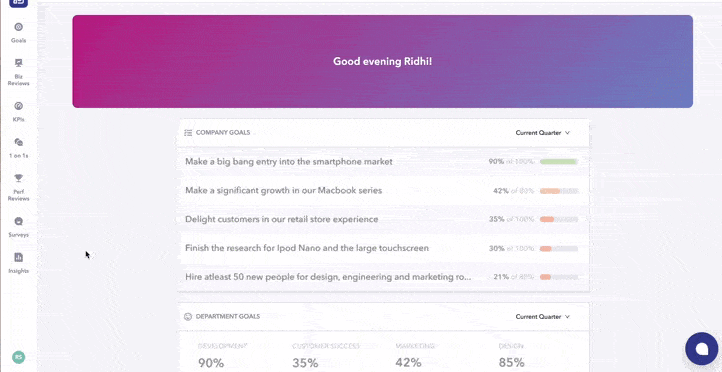
Need help crafting your survey questions? Download our sample diversity and inclusion survey questions here.
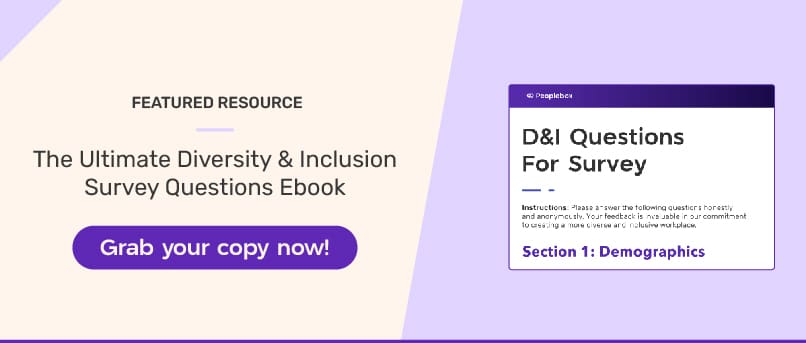
2. Adopt All-Inclusive Hiring Practices And Advertise To A Diverse Talent Pool
Another obvious place to look at to achieve diversity and inclusion in the workplace is the hiring process. To build truly diverse and inclusive teams, organizations need to adopt all-inclusive hiring practices. Here’s a quick look at how to make this happen:
Broaden Recruitment Channels: Expand the scope of your recruitment efforts by venturing beyond mainstream job boards. Engage with diverse networks, industry-specific groups, and associations tailored to underrepresented demographics. Actively participating in job fairs or events specifically targeting diversity can significantly expand your talent pool.
Diverse Job Descriptions: Review and modify job descriptions to ensure they appeal to a wider range of candidates. Be conscious of language and requirements that may unintentionally limit applications from certain demographics. Employing gender-neutral language and focusing on skills and qualifications can attract a more diverse array of applicants.
Partnerships and Outreach Programs: Collaborate with educational institutions, community organizations, or non-profits that focus on minority or underrepresented groups from different cultures. These partnerships not only widen your talent pipeline but also strengthen your commitment to fostering a diverse workforce.
Structured Interview Processes: Implement standardized and structured interviews that use the same set of questions for all candidates. This approach helps in evaluating skills and qualifications consistently, reducing bias in the assessment process.
Diversity Training for Recruiters and Interviewers: Train hiring managers and interviewers to recognize and eliminate unconscious bias. This empowers them to evaluate candidates based on their skills, experience, and potential, rather than irrelevant factors.
Inclusive Interview Panels: Form diverse interview panels representing a range of backgrounds and experiences. Such diversity in the assessment process showcases the company’s commitment to fostering an inclusive workplace.
Transparency in Recruitment Process: Provide clear information about the company culture, diversity initiatives, and career progression opportunities during the recruitment process. Transparency reassures candidates about the organization’s commitment to diversity and inclusion.
3. Use Inclusive Language In Company-Wide Communication
Inclusive language in company-wide communication is not just about words; it’s about fostering a culture of respect, equality, and belonging within your organization. The way we communicate plays a significant role in creating an inclusive workplace. Here’s a comprehensive look at how inclusive language can make a difference:
Gender-Neutral Language: Using gender-neutral terms and pronouns helps ensure that no one feels excluded based on their gender identity and supports gender diversity. Instead of using “he” or “she,” opt for “they” when referring to someone whose gender is unknown or irrelevant.
Avoiding Gender Stereotypes: Refrain from using language that reinforces stereotypes. Phrases like “man the helm” or “women are nurturing” can perpetuate gender biases.
Culturally Sensitive Terminology: Be mindful of cultural differences and use language that respects diverse backgrounds. What might be an innocuous phrase in one culture could be offensive in another. Sensitivity is key.
Accessibility and Clarity: Make sure your communication is clear and understandable to everyone. Avoid jargon and acronyms that may be unfamiliar to some employees. Your goal is to ensure that all team members, regardless of their background or experience, can easily comprehend your message.
Consistency: Consistency in the use of inclusive language is crucial. Develop a style guide for your organization to ensure that everyone is on the same page when it comes to using inclusive language in all communications.
4. Eliminate Bias in Performance Evaluation and Promotion Opportunities
In the pursuit of fostering diversity and inclusion in the workplace, eliminating bias from performance evaluation and promotion processes is crucial. Unbiased assessments not only level the playing field but also ensure that every employee has an equitable chance to succeed. Here are key strategies to help achieve this:
Objective Assessment Criteria: Develop clear and objective criteria for performance evaluations and promotions. These criteria should be based on specific job-related metrics and competencies, ensuring that the evaluation process is transparent and focused on measurable outcomes.
Training for Unbiased Feedback: Provide training for managers to ensure they deliver feedback free from unconscious bias. This training should empower them to provide constructive, fair, and impartial assessments of their team members. Here is a detailed article on how to unmask biases from performance review.
Equal Access to Opportunities: Ensure that all employees, regardless of their background, have equal access to mentorship, development programs, and growth opportunities. Identify high-potential employees from diverse backgrounds and actively support their professional advancement.
Data-Driven Evaluation: Use data-driven methods to evaluate performance. This helps to remove subjectivity and provides a clearer picture of an individual’s contributions to the organization.
Anonymous Peer Reviews: Implement anonymous peer reviews to obtain a well-rounded perspective on an employee’s performance, free from the influence of personal bias.
Here’s where performance management platforms like Peoplebox save the day. Peoplebox ensures full transparency and equality in the evaluation process through streamlined OKR management, guaranteeing that individuals are assessed based on the tangible work they contribute, leaving no room for unconscious bias.
With data-backed decisions and anonymous peer reviews, Peoplebox empowers organizations to create an inclusive culture where performance evaluations and promotions are fair, objective, and focused on measurable outcomes, ultimately driving organizational success.

5. Encourage 1:1 Discussions and Promote Open-Door Policies
Effective one-on-one discussions and open-door policies are the cornerstones of fostering an inclusive workplace culture. These practices empower employees and managers alike to engage in transparent and meaningful conversations. Let’s dive deep into these essential components of an inclusive work environment:
Regular One-on-One Discussions: One-on-one meetings are a fundamental aspect of employee-manager interactions. They serve as a space where both parties can discuss goals, performance, and any challenges they may be facing. Encouraging frequent 1:1 meetings can foster trust and demonstrate a commitment to individual development. Regular, personalized discussions help employees feel heard and supported, which, in turn, enhances their sense of belonging within the organization.
Open-Door Policies: Promoting an open-door policy means creating an environment where employees feel comfortable approaching leadership with any concerns or suggestions. It sends a powerful message that the organization values its employees’ voices and opinions. This transparency and approachability in leadership can encourage open communication, ultimately contributing to a more inclusive workplace culture.
Peoplebox helps in structuring and streamlining 1:1 discussions by offering features like personalized talking points, collaboration on meeting agendas and notes, recording meeting notes, setting action items, and calendar integration.
It also helps in tracking the overall culture of 1:1 meetings and sends timely reminders via Slack and email, ensuring that important discussions are not missed or postponed
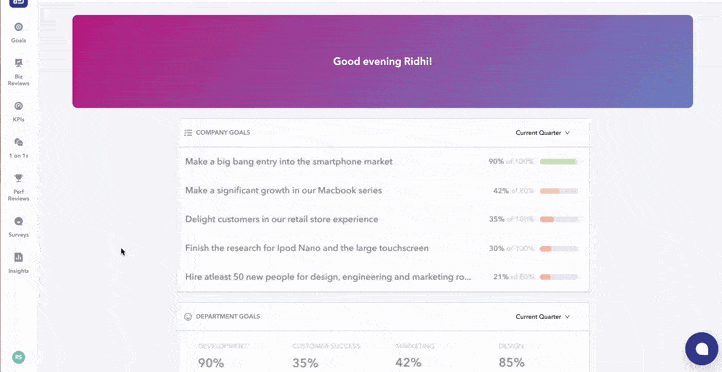
Tips to Review Diversity and Inclusion in the Workplace
Fostering diversity and inclusion in the workplace is an ongoing journey, and regularly reviewing your initiatives is essential to ensure progress and effectiveness. Here are some tips for conducting a comprehensive review of your D&I efforts:
Run Regular Diversity Surveys
Frequent diversity surveys are an invaluable tool for gauging employee sentiments about your company’s culture, leadership, and DEI initiatives. They are especially vital for remote or hybrid teams, where physical proximity no longer facilitates the natural exchange of ideas. These surveys provide a clear window into the success of your initiatives and areas that need improvement.
Imagine if a company’s diversity surveys highlight a decline in employee satisfaction with DEI initiatives. In response, HR and management can use the data to refine strategies, making DEI efforts more effective. Various survey types, such as pulse surveys or employee engagement surveys, enable you to collect actionable insights for improving processes like diversity recruitment.
To conduct an effective DEI survey, consider the following steps:
- Clarify the survey’s objectives: Are you looking to assess employee satisfaction, measure the effectiveness of initiatives, pinpoint areas for improvement, or reallocate resources?
- Design the survey, including considerations about its length, question selection, anonymity, and distribution methods.
- Ensure inclusivity by scrutinizing language, instructions, and questions for bias, gender coding, and discrimination, and make sure the survey is accessible to all employees, including those with visible or invisible disabilities.
Remember, the questions you ask matter. We’ve compiled a list of the best employee engagement survey questions to send out this year that you can leverage right away.
Use Metrics and Data to Evaluate DEI Initiatives
Establishing diversity Key Performance Indicators (KPIs) provides a structured approach to measuring the success of your DEI initiatives. These KPIs may vary from organization to organization but serve as a means to monitor progress effectively.
Consider a scenario where a retail company focuses on increasing diversity in its workforce. They implement KPIs that track the percentage of diverse candidates in the hiring pipeline, which provides data to optimize their recruitment strategies.
When working with diversity data, remember to:
- Analyze recruitment data, Equal Employment Opportunity (EEO) surveys, candidate feedback, and the composition of your hiring pipeline.
- Examine historical data related to employee demographics, feedback, and insights from Employee Resource Groups (ERGs).
- Follow up with candidates after the hiring process to gather insights into their experiences.
- Deploy team-level surveys to gauge sentiment around company culture, team dynamics, leadership support, and more.
Leverage Performance and Peer Reviews
Performance and peer reviews offer valuable insights for both employees and managers to recognize strengths and areas for improvement. To ensure these reviews are unbiased and supportive of your DEI goals, consider the following strategies:
- Audit your existing performance review process by seeking anonymous employee feedback to pinpoint areas for improvement.
- Focus on eliminating bias in performance reviews, making them outcome-driven rather than influenced by subjective opinions or favoritism.
- Set specific goals for your performance reviews beyond performance evaluation to include employee viewpoints and perspectives on their roles and the company.
- Collaborate with leaders, managers, and stakeholders involved in the review process to determine what insights are sought.
- Secure buy-in from your employees by informing them about changes to the review process and the type of feedback you’re looking for.
Download FREE Peer Review Feedback Template.

Incorporating these tips into your D&I review process will enable you to conduct a more thorough and meaningful evaluation of your efforts.
Driving Diversity and Inclusion in the Workplace with Peoplebox
Harness the power of Peoplebox to drive diversity and inclusion in the workplace through effective performance reviews and employee feedback. Peoplebox offers a structured, data-driven approach to evaluations, reducing unconscious bias and promoting fairness. With a focus on Objectives and Key Results (OKRs), it aligns employees’ goals with your company’s mission, fostering unity and diversity. Streamlined 1:1 discussions and transparent development paths ensure open communication and equal opportunities for all.
Empower your employees to take charge of their growth and contribute to a diverse, inclusive, and successful workplace. Ready to embrace diversity with Peoplebox? Get in touch with our experts today!

